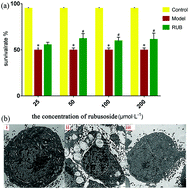当前位置:
X-MOL 学术
›
Mol. Omics
›
论文详情
Our official English website, www.x-mol.net, welcomes your
feedback! (Note: you will need to create a separate account there.)
Metabolomics analysis of the protective effect of rubusoside on palmitic acid-induced lipotoxicity in INS-1 cells using UPLC-Q/TOF MS.
Molecular Omics ( IF 3.0 ) Pub Date : 2019-05-09 , DOI: 10.1039/c9mo00029a Hua Zheng 1 , Jinxia Wu 2 , Hong Huang 3 , Chunmei Meng 1 , Weidong Li 1 , Tianli Wei 2 , Zhiheng Su 2
Molecular Omics ( IF 3.0 ) Pub Date : 2019-05-09 , DOI: 10.1039/c9mo00029a Hua Zheng 1 , Jinxia Wu 2 , Hong Huang 3 , Chunmei Meng 1 , Weidong Li 1 , Tianli Wei 2 , Zhiheng Su 2
Affiliation

|
Diabetes is one of the most severe chronic diseases worldwide. It is widely accepted that apoptosis of the pancreatic beta cell is an important cause for the induction of hyperglycemia and high levels of free fatty acids (FFAs), also called lipotoxicity associated with pancreatic beta cell dysfunction. Lipotoxicity has been proven to be an important pathogenic factor of diabetes. However, until now, the mechanism of FFA-induced lipotoxicity in INS-1 cells has not been fully understood. Current anti-diabetic drugs that protect islet cells are often toxic to healthy cells, resulting in negative side effects. Thus, there is an urgent need to identify more effective and safer anti-diabetic agents to protect pancreatic islet cells. Rubusoside (RUB) is a major ingredient in the leaves of Rubus suavissimus S. Lee, which decreases blood glucose levels by protecting pancreatic islet cells. However, the exact mechanism of this effect is unknown. In this study, metabolomics experiments based on UPLC-Q/TOF MS characterized a total of 15 metabolites as potential biomarkers associated with lipotoxicity induced by palmitic acid in INS-1 cells. According to the metabolic pathway analysis, pentose and glucuronate interconversions, and glycerophospholipid metabolism were recognized as the most influenced metabolic pathways associated with lipotoxicity. Unexpectedly, deviations of 14 metabolites in lipotoxic INS-1 cells were regulated by RUB, suggesting synergistic mediation of the abnormal metabolic pathways. The metabolomics strategy based on UPLC/Q-TOF MS analysis provides a new insight into the mechanisms of lipotoxicity induced by palmitic acid and the anti-lipotoxic activity of RUB in INS-1 cells.
中文翻译:

使用UPLC-Q / TOF MS对红景天苷对棕榈酸诱导的INS-1细胞脂毒性的保护作用的代谢组学分析。
糖尿病是世界上最严重的慢性疾病之一。胰腺β细胞的凋亡是引起高血糖和高水平的游离脂肪酸(FFA)的重要原因,也被称为与胰腺β细胞功能障碍有关的脂毒性。脂质毒性已被证明是糖尿病的重要致病因素。但是,到目前为止,尚未完全了解FF-1诱导INS-1细胞中脂毒性的机制。当前保护胰岛细胞的抗糖尿病药物通常对健康细胞有毒,导致不良副作用。因此,迫切需要鉴定更有效和更安全的抗糖尿病药来保护胰岛细胞。悬钩子苷(RUB)是悬钩子悬钩子叶中的主要成分,通过保护胰岛细胞降低血糖水平。但是,这种作用的确切机理尚不清楚。在这项研究中,基于UPLC-Q / TOF MS的代谢组学实验表征了总共15种代谢物,它们是与棕榈酸在INS-1细胞中诱导的脂毒性相关的潜在生物标志物。根据代谢途径分析,戊糖和葡萄糖醛酸酯的相互转化以及甘油磷脂代谢被认为是与脂毒性相关的影响最大的代谢途径。出乎意料的是,RUB调节了脂毒性INS-1细胞中14种代谢物的偏离,表明异常代谢途径的协同介导作用。
更新日期:2019-06-11
中文翻译:

使用UPLC-Q / TOF MS对红景天苷对棕榈酸诱导的INS-1细胞脂毒性的保护作用的代谢组学分析。
糖尿病是世界上最严重的慢性疾病之一。胰腺β细胞的凋亡是引起高血糖和高水平的游离脂肪酸(FFA)的重要原因,也被称为与胰腺β细胞功能障碍有关的脂毒性。脂质毒性已被证明是糖尿病的重要致病因素。但是,到目前为止,尚未完全了解FF-1诱导INS-1细胞中脂毒性的机制。当前保护胰岛细胞的抗糖尿病药物通常对健康细胞有毒,导致不良副作用。因此,迫切需要鉴定更有效和更安全的抗糖尿病药来保护胰岛细胞。悬钩子苷(RUB)是悬钩子悬钩子叶中的主要成分,通过保护胰岛细胞降低血糖水平。但是,这种作用的确切机理尚不清楚。在这项研究中,基于UPLC-Q / TOF MS的代谢组学实验表征了总共15种代谢物,它们是与棕榈酸在INS-1细胞中诱导的脂毒性相关的潜在生物标志物。根据代谢途径分析,戊糖和葡萄糖醛酸酯的相互转化以及甘油磷脂代谢被认为是与脂毒性相关的影响最大的代谢途径。出乎意料的是,RUB调节了脂毒性INS-1细胞中14种代谢物的偏离,表明异常代谢途径的协同介导作用。











































 京公网安备 11010802027423号
京公网安备 11010802027423号